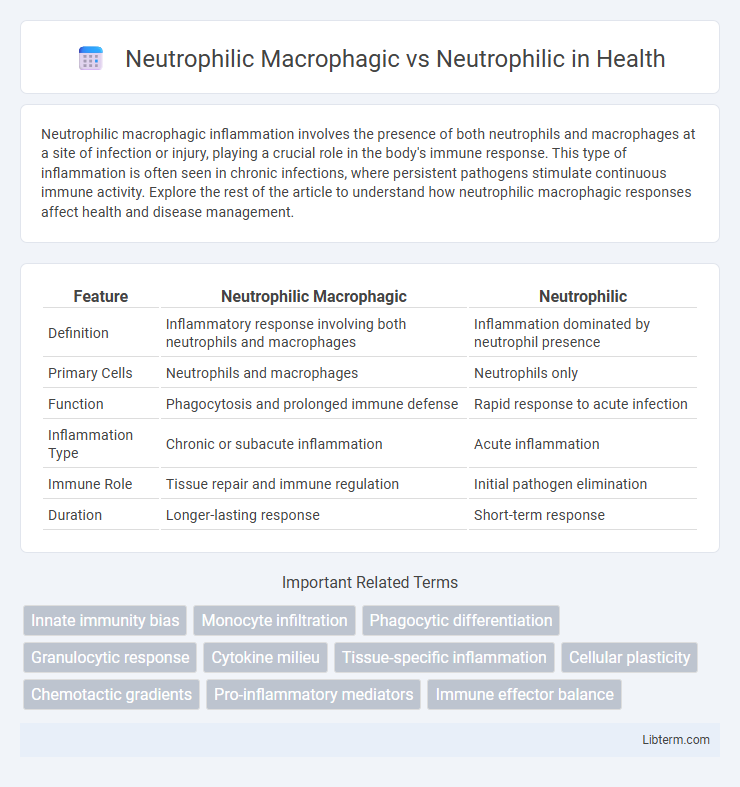Neutrophilic macrophagic inflammation involves the presence of both neutrophils and macrophages at a site of infection or injury, playing a crucial role in the body's immune response. This type of inflammation is often seen in chronic infections, where persistent pathogens stimulate continuous immune activity. Explore the rest of the article to understand how neutrophilic macrophagic responses affect health and disease management.
Table of Comparison
| Feature | Neutrophilic Macrophagic | Neutrophilic |
|---|---|---|
| Definition | Inflammatory response involving both neutrophils and macrophages | Inflammation dominated by neutrophil presence |
| Primary Cells | Neutrophils and macrophages | Neutrophils only |
| Function | Phagocytosis and prolonged immune defense | Rapid response to acute infection |
| Inflammation Type | Chronic or subacute inflammation | Acute inflammation |
| Immune Role | Tissue repair and immune regulation | Initial pathogen elimination |
| Duration | Longer-lasting response | Short-term response |
Introduction to Neutrophilic and Neutrophilic Macrophagic Responses
Neutrophilic responses primarily involve the rapid recruitment and activation of neutrophils to sites of infection or injury, where they engulf pathogens and release cytotoxic enzymes to control acute inflammation. Neutrophilic macrophagic responses incorporate both neutrophils and macrophages, with macrophages orchestrating the resolution phase by clearing apoptotic neutrophils and promoting tissue repair through anti-inflammatory cytokine secretion. Understanding the balance between these cellular activities is crucial for modulating immune responses and preventing chronic inflammation or tissue damage.
Overview of Neutrophils in Immune Function
Neutrophils serve as the first line of defense in the innate immune system by rapidly migrating to infection sites and performing phagocytosis of pathogens. Neutrophilic macrophagic responses involve both neutrophils and macrophages cooperating to enhance pathogen clearance and inflammation regulation. Understanding the distinct roles of neutrophilic versus neutrophilic macrophagic activity is critical for optimizing treatments targeting immune response and inflammation control.
Role of Macrophages in Inflammatory Processes
Macrophages play a critical role in neutrophilic inflammation by modulating the immune response through phagocytosis and cytokine production, which aids in tissue repair and resolution of inflammation. Unlike purely neutrophilic inflammation, macrophage involvement ensures the clearance of apoptotic neutrophils and the transition from acute to chronic inflammation phases. This functional interplay enhances the overall immune regulation, preventing excessive tissue damage and promoting homeostasis.
Neutrophilic Infiltration: Mechanisms and Significance
Neutrophilic infiltration involves the rapid recruitment of neutrophils to sites of inflammation through chemotactic signals such as IL-8 and complement factors, playing a crucial role in acute immune responses. Neutrophilic macrophagic infiltration characterizes a mixed cellular response where neutrophils and macrophages collaboratively mediate pathogen clearance and tissue remodeling, modulating inflammation resolution. The dynamic interplay between neutrophils and macrophages influences the balance between pro-inflammatory activities and repair mechanisms, impacting disease progression and healing outcomes.
Neutrophilic Macrophagic Response: Definition and Characteristics
Neutrophilic macrophagic response involves a coordinated immune reaction where both neutrophils and macrophages actively participate in pathogen clearance and tissue repair. This response is characterized by intense neutrophil infiltration alongside macrophage activation, promoting efficient phagocytosis and cytokine release. Unlike a purely neutrophilic response, the neutrophilic macrophagic response entails a balanced interplay between innate immune cells, enhancing inflammation resolution and tissue remodeling.
Histopathological Differences: Neutrophilic vs. Neutrophilic Macrophagic
Neutrophilic inflammation is characterized by an abundant infiltration of neutrophils in the affected tissue, reflecting an acute response to infection or injury with primarily polymorphonuclear leukocytes present. In contrast, neutrophilic macrophagic inflammation exhibits a mixed cellular infiltrate comprising both neutrophils and activated macrophages, indicating a more complex or ongoing immune response with histiocytes playing a key phagocytic role. Histopathological examination reveals that neutrophilic patterns show predominant neutrophil clustering and tissue necrosis, whereas neutrophilic macrophagic patterns present granulomatous features, including macrophage aggregation and potential multinucleated giant cells.
Clinical Manifestations and Differential Diagnosis
Neutrophilic macrophagic inflammation presents with both neutrophil and macrophage infiltration, often seen in chronic inflammatory diseases such as granulomatous infections and vasculitis, whereas purely neutrophilic inflammation typically indicates acute bacterial infections or abscess formation. Clinical manifestations of neutrophilic macrophagic patterns include persistent fever, lymphadenopathy, and tissue necrosis, contrasting with the acute pain, swelling, and erythema characteristic of neutrophilic-only responses. Differential diagnosis requires histopathological analysis and immunohistochemical staining to distinguish macrophage presence and granuloma formation in neutrophilic macrophagic conditions versus rapid neutrophil predominance in purely neutrophilic inflammation.
Diseases Associated with Each Response Type
Neutrophilic macrophagic responses are commonly linked with chronic inflammatory diseases such as tuberculosis and sarcoidosis, where both neutrophils and macrophages play critical roles in granuloma formation and pathogen clearance. Neutrophilic responses primarily dominate acute bacterial infections like abscesses and pneumonia, characterized by rapid neutrophil accumulation to combat invading pathogens. Distinguishing these responses aids in diagnosing and tailoring treatment strategies for diseases like chronic granulomatous disease (neutrophilic macrophagic) versus acute bacterial sepsis (neutrophilic).
Diagnostic Criteria and Laboratory Findings
Neutrophilic macrophagic inflammation is characterized by the simultaneous presence of neutrophils and macrophages in tissue samples, with diagnostic criteria including mixed cell infiltrates seen on histopathology and immunohistochemical staining, whereas neutrophilic inflammation primarily features an abundance of neutrophils without significant macrophage involvement. Laboratory findings in neutrophilic macrophagic conditions often reveal elevated levels of inflammatory markers such as C-reactive protein (CRP) and increased macrophage-related cytokines like TNF-a and IL-6, while neutrophilic inflammation typically shows leukocytosis with neutrophilia and elevated neutrophil elastase activity. Differentiating between these two types involves correlating clinical presentation with specific cellular markers, flow cytometry data, and tissue biopsy results for precise diagnosis and targeted treatment strategies.
Implications for Treatment and Prognosis
Neutrophilic macrophagic inflammation involves both neutrophils and macrophages, indicating a mixed immune response that often requires combined anti-inflammatory and immunomodulatory treatments for effective management. In contrast, purely neutrophilic inflammation suggests acute bacterial infection, typically responding well to targeted antibiotic therapy. Prognosis in neutrophilic macrophagic cases may be more complex due to potential chronicity and tissue remodeling, whereas neutrophilic inflammation alone usually has a more straightforward recovery trajectory.
Neutrophilic Macrophagic Infographic

 libterm.com
libterm.com